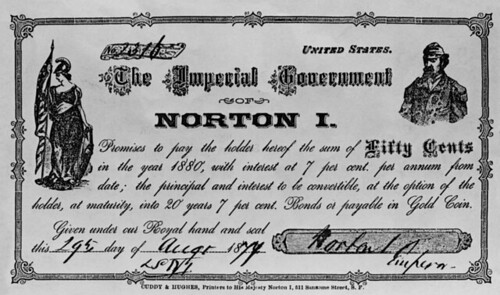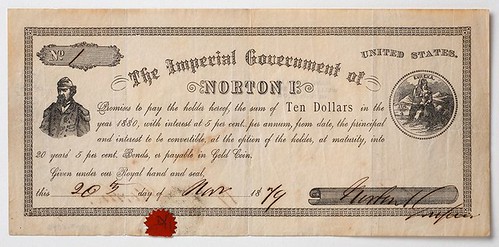
PREV ARTICLE
NEXT ARTICLE
FULL ISSUE
PREV FULL ISSUE
NOTES ON EMPEROR NORTON'S PRINTERSJohn Lumea is from The Emperor's Bridge Campaign, the San Francisco-based nonprofit that advances the legacy of Emperor Norton, the well-known eccentric who captivated the world with his behavior and proclamations. John has written a new article about the Emperor's numismatic connection, the printed "bonds" or "imperial promissory notes" he sold to his local "subjects" and passing tourists alike. The article focuses on a topic I'm not aware has ever been covered before - the printers of the scrip and Norton's relationships with them. Among the article's findings are
Here's an excerpt - be sure to read the complete article online. -Editor Cuddy & Hughes
Perhaps it was just a throwaway line — the latest in an endless parade of such lines trolled out by newspapers and magazines, at the Emperor's expense, to fill out a given edition's final column inches. But, perhaps it also was offered for a more specific purpose: as a preemptive disclaimer against the appearance of any conflict of interest, given that the printer of the paper and the printer of the bonds were one and the same: the firm of John Cuddy (c.1844–1914) and Edward C. Hughes (c.1848–1912), operating professionally as Cuddy & Hughes. In fact, Cuddy & Hughes and the Pacific Appeal occupied the same building — at 511 Sansome Street, on the southwest corner of Sansome and Merchant. In his biography San Francisco Lithographer: African American Artist Grafton Tyler Brown (University of Oklahoma Press, 2014), the historian Robert J. Chandler surveys the San Francisco printing scene between 1865 and 1880 and asks [emphasis added]: With sharp competition from 125 San Francisco printing and lithographic firms over fifteen years, how did a job printer stand out? In 1870, John Cuddy and Edward C. Hughes, in business only since 1869 after buying out their employer, Thomas B. Deffebach, found a novel way. They became "Printers to His Majesty, Norton I." The prerogative of any government is to issue money, and a fifty-cent imperial bond dated November 11, 1870, is the earliest scrip known. Cuddy & Hughes already printed African American Peter Anderson's Pacific Appeal and billheads, and six weeks later, His Majesty chose it as his official paper. The two ultimately produced five differently designed bonds for the Imperial Government of Norton I, Emperor of the United States and Protector of Mexico. Today one of their fifty-cent notes brings $16,000. Here's a Cuddy & Hughes imperial note that Emperor Norton signed and sold on 29 August 1874:  Bond of The Imperial Government of Norton I, made by Cuddy & Hughes and signed by Emperor Norton on 29 August 1874. Source: Jewish Museum of the American West. The line along the bottom edge — "CUDDY & HUGHES, Printers to His Majesty Norton I, 511 Sansome Street, S.F." — goes right to Chandler's point. Whatever might have been the personal sympathies of John Cuddy or Edward Hughes towards the Emperor, these notes were first and foremost — for them — advertisements for the firm. Within one small sheet, they were able to convey the quality of their paper; their design and typographical sensibilities / capabilities; and the quality of their printing. C.A. Murdock & Co.
Emperor Norton liked the Unitarians — and one of the Emperor's favorite ministers was Horatio Stebbins, who succeeded Thomas Starr King at the First Unitarian Church. Murdock — a staunch Unitarian — was a member of this church; and it seems that this is where he and the Emperor befriended one another. Murdock's notes are distinguished by the absence of any promotional copy for his own business — which may say any number of things about Murdock, probably all of them good. Here's a Murdock note signed and sold by Emperor Norton on 20 November 1879.  Bond of The Imperial Government of Norton I, made by Charles A. Murdock & Co. and signed by Emperor Norton on 20 November 1879. Collection of the Wells Fargo History Museum / San Francisco. Source: Groove Central LA Charles Murdock was a keen and sensitive observer of his world. And he lived a deeply engaged and distinguished civic and professional life in San Francisco and Northern California — a life that provided him with a front-row seat to the early development of his adopted city and region, and that brought him in touch with many of its most notable writers and public figures, including Bret Harte, Mark Twain, John Muir and Joaquin Miller. So it was that, in 1921, at the behest of friends, Murdock published a late-in-life memoir, which he modestly titled A Backward Glance at Eighty. Here's Murdock's charming recollection of his relationship with the Emperor [emphasis mine]: No glance at old San Francisco can be considered complete which does not at least recognize Emperor Norton, a picturesque figure of its life. A heavy, elderly man, probably Jewish, who paraded the streets in a dingy uniform with conspicuous epaulets, a plumed hat, and a knobby cane. Whether he was a pretender or imagined that he was an emperor no one knew or seemed to care. He was good-natured, and he was humored. Everybody bought his scrip in fifty cents denomination. I was his favored printer, and he assured me that when he came into his estate he would make me chancellor of the exchequer. He often attended the services of the Unitarian church, and expressed his feeling that there were too many churches and that when the empire was established he should request all to accept the Unitarian church. He once asked me if I could select from among the ladies of our church a suitable empress. I told him I thought I might, but that he must be ready to provide for her handsomely; that no man thought of keeping a bird until he had a cage, and that a queen must have a palace. He was satisfied, and I never was called upon. To read the complete article, see:
To read earlier E-Sylum articles, see:
Wayne Homren, Editor The Numismatic Bibliomania Society is a non-profit organization promoting numismatic literature. See our web site at coinbooks.org. To submit items for publication in The E-Sylum, write to the Editor at this address: whomren@gmail.com To subscribe go to: https://my.binhost.com/lists/listinfo/esylum All Rights Reserved. NBS Home Page Contact the NBS webmaster 
|